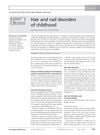Hair That Is Difficult to Manage in a Hispanic Girl
July 2017
in “
Skin appendage disorders
”
TLDR A 9-year-old Hispanic girl has Uncombable Hair Syndrome, which may improve with age and biotin treatment.
A 9-year-old Hispanic girl presented with unmanageable hair, diagnosed as short anagen syndrome at age 3. Examination revealed dry, light brown hair with triangular and kidney-shaped shafts. The diagnosis was revised to Uncombable Hair Syndrome, an autosomal dominant disorder characterized by dry, unruly hair with a grooved and flat surface. Scanning electron microscopy, the gold standard for diagnosis, was unavailable, so transverse sectioning was used. Treatment included biotin and minoxidil. The condition typically improves with age, and biotin can help make hair more manageable. No other physical or neurological symptoms were present.





